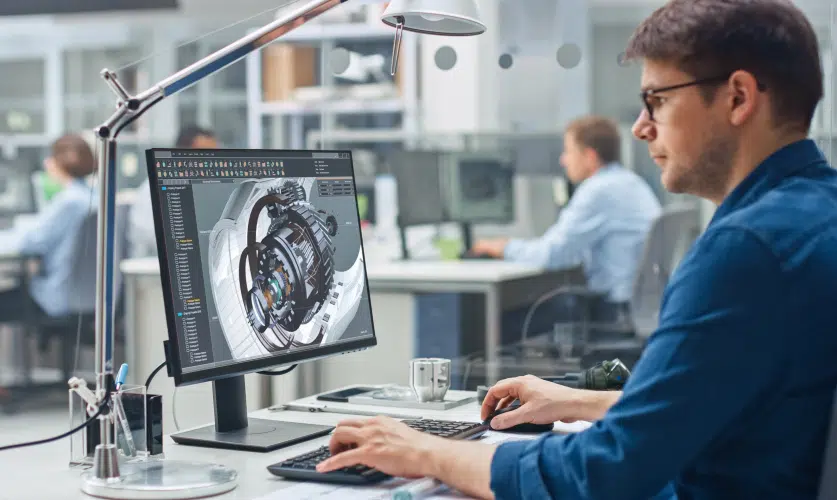mechanical engineering
Development, manufacture and maintenance of machinery and equipment
CAD-based real-time simulation
Mechanical engineering places very specific demands on simulation systems for virtual commissioning (VC). Typical tasks in this area include requirements analyses, CAD-based real-time simulation (e.g. FEM/CFD), simulation of manufacturing and assembly processes involving many different devices, coupling of a wide variety of automation systems, and testing and maintenance.
The VC is based on 3D CAD data from real machines and systems, which is imported directly into the WinMOD-SIMLINE system. Components and piece goods are also integrated as 3D objects via CAD imports. In our 3D editor, you can position, combine and kinematise the machines and, if necessary, directly adjust axis rotation points, travel distances or the gripping mechanism for the precise simulation of complex machines. The many different WinMOD-SIMLINE 3D sensors then capture the movements of your components and machine axes with precise contours and evaluate them in real time.


Diversity in automation and devices
A wide variety of control and bus systems are used in mechanical engineering. A machine for the European market, for example, may be equipped with a completely different control system than one for the American market. This is precisely where one of the strengths of the WinMOD-SIMLINE system lies. It enables many of these automation systems to be linked easily and efficiently. It is particularly important that you can link several different control systems to a WinMOD system at the same time, so that a complex plant can be put into operation virtually as a whole.
The drive technology, whether servo axes, hydraulics, pneumatics or frequency converters, can also be very diverse. Here at the WinMOD Customer Center, we offer extensive libraries with many virtual devices. These include real control-relevant behaviour with signal coupling, start-up behaviour, travel curves, operating modes and even communication protocols for scanners, for example. As a user, you can use these directly, easily adapt them if necessary, and even create your own.
Further factory automation solutions
Sorting and picking systems for small items such as cartons, plastic boxes or other piece goods. Transport is via classic roller conveyors, belt conveyors
as well as the typical cam roller conveyors found here,
Belt curves and accumulation roller conveyors.
This area of technology encompasses conveyor systems that transport and sort pallets and mesh boxes. The conveyor elements are large roller and chain conveyors combined with lifting, rotating and shifting tables. Magazines for empty pallets are also typical here.
These systems are usually fully automated high-bay warehouses that are operated by storage and retrieval machines and controlled by distributed automation systems. Warehouse management systems generate the orders for storage and retrieval.
Automated systems that pick up parts from A to B and place them down again with a defined orientation – typically for loading, sorting, picking or packing. Core systems are industrial robots (Delta, SCARA, 6 axes, Cartesian) or gantry axes.
Robotics plays a central role in modern manufacturing by enabling the automation of production processes and increasing efficiency and precision. Robots are used in various areas, such as welding, assembly, painting or packaging products.
Production lines combine processes, material flow and controls into a production system with guaranteed cycle times and quality. They consist of combinations of assembly, processing and testing stations. In addition, there is transfer technology, buffers and often a highly specialised automation system.
Electric Monorail Systems are used as connecting conveyor technology over long distances. The overhead trolleys run fully automatically with integrated electric drives and controls and are usually routed via a central control system.
This chain-driven overhead or floor conveyor technology is powered by continuously running power strands (chains). Transport trolleys are coupled in, transported, decoupled at stoppers and buffered via chain drivers („dogs“).
Automated self-driving vehicles as a connecting material flow solution. Driving is either completely trackless via defined tracks or markers (AGV) or via free navigation with automatic dynamic obstacle avoidance (AMR).
Engineering discipline for the development, manufacture and maintenance of machines, plants and production systems. Typical applications include machine tools, handling technology, automotive/aerospace, packaging and assembly plants.